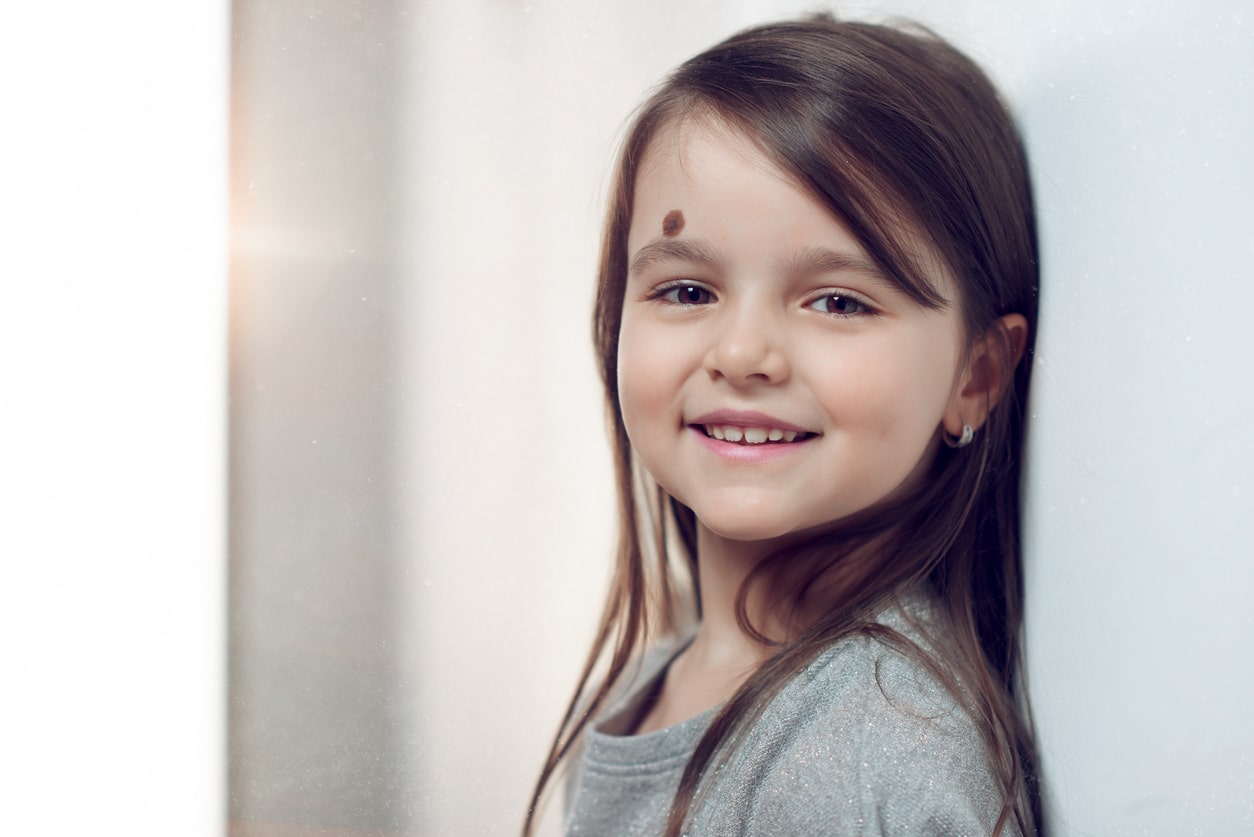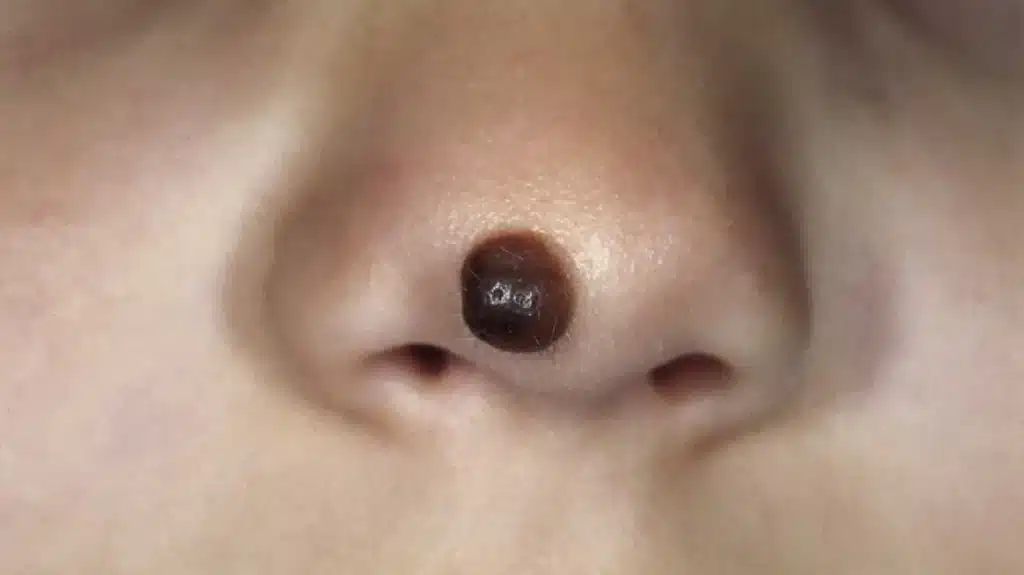
Mole removal in a child can have a significant impact on self-esteem and social well-being.
Children often have moles on their skin. These are usually benign and present at birth (in about 1% of newborns) or develop later in life. However, some moles can be large, unsightly or interfere with normal activities. These moles can affect how a child feels about themselves and how they relate to others. Prominent or cosmetically significant moles can have a significant impact on a child's self-image and lead to bullying by peers. This can be especially challenging during adolescence when children become more aware of their appearance and face peer pressure. Mole removal may be an option for parents who want to help their child cope with a bothersome mole.
A prominent mole in a child can be defined by its size, location, and colour. Prominent facial moles may have a greater impact on a child's self-image. This makes mole removal more important for certain areas where a mole is more visible. Here are some general guidelines:
Any mole that is larger than a small bead (3-5 mm) is generally considered to be a larger mole. These may be more noticeable on the face. However, even smaller moles can be prominent if they are located in a highly visible area.
Moles that are darker or have a different colour than the surrounding skin may be more noticeable. This can be especially true if the mole is located on the face or other highly visible areas.
Moles that are located on the face, especially in the central or highly visible areas, may be more prominent than moles located elsewhere on the body. For example, a mole on the nose, forehead, or cheek may be more noticeable than a mole on the back. Here are some examples of areas of the face where a mole may be more prominent or cosmetically significant:
It's important to note that these are general guidelines and not hard and fast rules.

Visible or large and disfiguring moles can cause significant psychological distress for children. Children with prominent moles may feel self-conscious, embarrassed, and even lonely. This can lead to social isolation, anxiety, or low self-esteem, which can impact the child's overall quality of life and mental health. Therefore, it may be appropriate to consider cosmetic mole removal to help alleviate these negative feelings and boost their confidence and self-image.
Children can become self-conscious about their appearance from a very young age, with some noticing as early as two years old. Others may not become aware of any negative attention until they are older. Personally, my daughter started noticing moles around the age of two. Children may become more aware of prominent moles as they become more socially engaged and begin to compare themselves to their peers. This can start as early as preschool age but is more common during the school years when children become more interested in social interactions and appearance. Adolescents may feel more pressure to conform to social norms, as appearance and social acceptance are often important to young people. They may be particularly affected by the impact of a prominent mole on their self-esteem and confidence.
Mole removal can help children feel more comfortable in social situations and reduce the likelihood of negative attention or comments about their appearance. This can boost their confidence and self-image, improve their overall quality of life and increase their confidence and security.
If your child has a prominent mole, you may be considering mole removal. However, deciding when it's appropriate to consider this option can be challenging.

Determining the optimal time for mole removal involves careful consideration of several factors, including the child's age and developmental stage, the size and location of the mole, and the potential risks and benefits of the procedure. Consulting with a doctor is essential to determine whether mole removal is necessary and, if so, when is the best time to undergo the procedure.
Moles tend to grow faster during childhood and adolescence due to hormonal changes and increased exposure to sunlight. In general, it is recommended to remove moles early in childhood when they are smaller and have a better chance of healing with minimal scarring. Early removal can also prevent negative psychological impacts on the child's self-esteem and confidence.
The more prominent the mole, the earlier mole removal should be considered. The earlier a prominent mole is removed in a child, the better the outcome in general.
However, mole removal should be considered only if it is necessary and not solely for cosmetic reasons. Parents need to assess if it is a reasonable course of action and consider the potential benefits and risks of mole removal, as well as the child's personal feelings about the mole. The child should also be sure that they want the mole removed, and not just do it to please the parent.
Weigh the decision to remove a mole in a child with care, taking into account the child's developmental period, their ability to cooperate with the procedure, and the psychological impact of the mole.
Mole removal procedures can be challenging for children to understand and cooperate with, and the ability to do so varies at different stages of development. For example, toddlers may have difficulty sitting still, while older children may have anxiety about the procedure. Parents should work with their doctor to determine the best time for mole removal based on the child's developmental stage. Here are some age-specific considerations:
During infancy and toddlerhood, children are typically unaware of their appearance, including any moles they may have. Removing moles for cosmetic reasons is generally not recommended while the child is still an infant or toddler because of their inability to understand the procedure and follow instructions. This makes it difficult to remove a mole in a safe and effective manner. However, for moles causing medical issues or significant distress, early removal may be necessary, and general anesthesia may be required.
During the preschool years, children begin to develop a sense of self-awareness and may become more self-conscious about their appearance. Early childhood is a good time to consider mole removal if the child is already distressed by the mole's appearance. Preschool-aged children may have a better understanding of mole removal than infants, but they may still have difficulty sitting still and cooperating with mole removal. Distractions or mild sedation may be helpful to facilitate cooperation.
Children in this age range are typically more aware of their appearance and may become self-conscious about a prominent mole. In Singapore, with its focus on achievement, school-aged children may also experience bullying or teasing due to prominent moles, which may further impact their self-esteem.
School-aged children are generally more cooperative than preschoolers. They may be able to understand and cooperate with mole removal procedures without the need for sedation and can follow post-procedure care instructions. Thus, this might be an ideal time to consider mole removal if the child expresses interest. However, they may also be more self-conscious and aware of the appearance of their moles, which may impact their willingness to undergo the procedure.
During adolescence, self-image becomes increasingly important to many children. In Singapore, where appearance plays a significant role in social interactions, adolescents may also be more concerned about the impact of prominent moles on their appearance. Prominent moles may lead to decreased self-confidence and may impact their social lives.
Adolescence can be a good time to consider mole removal. Teens may be motivated to have their moles removed for cosmetic reasons and may be more willing to undergo the procedure. They are typically able to understand and cooperate with the procedure and take responsibility for following post-procedure care instructions closely. However, they may also be more anxious about the procedure and benefit from detailed discussions with medical professionals.
Ultimately, the decision to pursue mole removal should be a joint decision between the child, parents, and medical professionals. It's important to ensure that the child is mature enough to understand the procedure and express their own desires regarding mole removal. However, this must also be balanced against the benefit of early removal for very large moles.
If you're considering mole removal for your child, it's important to work with a qualified and experienced doctor who can evaluate the mole and determine the best course of action. The doctor can also help assess whether mole removal is a reasonable course of action based on the mole’s characteristics and the child's psychological and emotional needs. Definitely do not try any of these cheapest mole removal methods in Singapore on your child.
Overall, mole removal can have a positive impact on a child's self-esteem and social well-being. At 1Aesthetics, Medical & Surgery, mole removal is one of the most common medical aesthetics procedures that I perform. If you're concerned about a prominent mole on your child's face, don’t hesitate to schedule a consultation to discuss if mole removal is the right choice for your child’s needs.
Address:
1Aesthetics, Medical & Surgery
#14-90 The Central Tower 1
8 Eu Tong Sen Street
Singapore 059818
Mon-Fri 10 AM to 730 PM
Sat 10 AM to 6 PM
Phone / WhatsApp:
+65 66125173 / +65 84899962
Email:
[email protected]